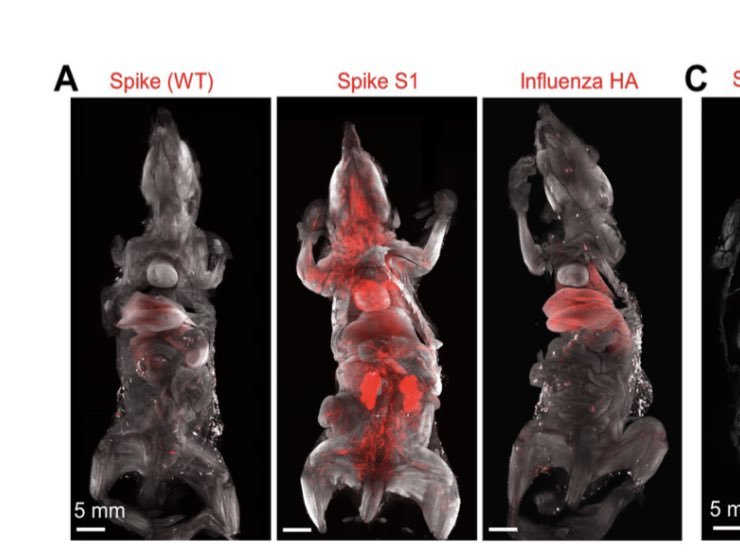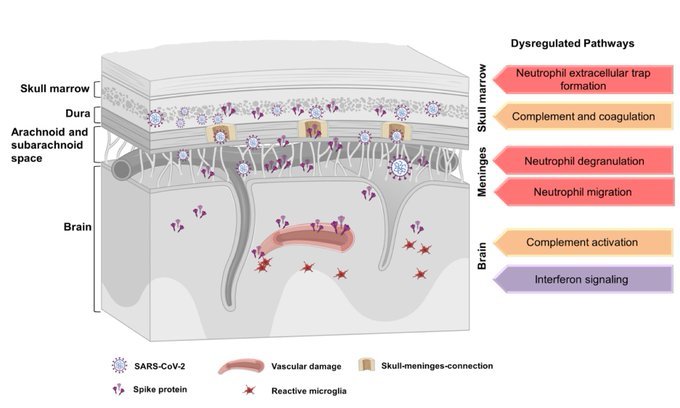Long Covid & Brain Symptoms
In a previous blog I discussed the possible role of the SARS-CoV-2 spike protein in a myriad of unusual symptoms seen in patients, and mentioned that spike protein was shown to be unexpectedly persisting in people's bodies . For this blog I would like to highlight an important piece of recent research concerning the persistence of the spike protein in the brain.
A research team at Munich University have just released a study (currently not peer-reviewed) which used mouse models and human post-mortem tissues to investigate the presence and distribution of the SARS-CoV-2 spike protein in the skull, brain meninges and the brain itself.
The first part of the study on mice showed that when they were injected with part of the spike protein (the S1 part) it spread within 30 minutes to most organs, including the heart, lung, liver, kidney, intestine, thymus, spleen, and pancreas. More significantly, the S1 subunit had also spread to the brain (the prefrontal cortex) as well as within the skull bone marrow and the channels between the marrow and the meninges that surround the brain. The S1 subunit had also accumulated in the spinal cord and the blood vessels of the brain.
The red colour in the ‘Spike S1’ mouse shows the distribution of the S1 spike protein subunit within the organs of the mouse 30 minutes after injection.
Another part of the mouse study took a closer look at what the effect the S1 subunit was having on the brains of the mice. If found that the presence of the S1 subunit in the skull marrow could signal into the brain to induce long-lasting pathological effects, including cell death and neuronal injury.
The second part of the study looked at the presence of spike protein in human post-mortem tissues, namely skulls and brain meninges. As with the mouse study, spike protein was found in some of the skull marrow and brain meninges examined. Of note, the spike protein was found in samples both from people who had died of COVID and those that hadn’t.
The figure below summarises the distribution of the spike protein in the brain and skull and the observed effects.
What does this mean?
The findings of the latest study led the researchers to suggest that the spike’s persistence in the brain may be contributing to some of the long-term neurological symptoms seen with long covid, for instance headaches, brain fog and cognitive impairment.
Previous research supports this hypothesis. A scientific paper in 2022 detailed how deceased patients with COVID-19 had inflammation around the blood vessels in their brains, and how the spike protein could damage the thin membrane that lines the inside of the blood vessels in the heart in an animal model. The same paper also showed that the spike protein could disrupt an in vitro (lab) model of the blood-brain barrier (BBB), and that it can cross the BBB resulting in perivascular inflammation. Furthermore, a 2022 study in mice showed that when they were injected with the spike S1 protein, it induced a cognitive deficit and anxiety-like behaviour in them and induced the death of their brain cells.
To sum up, this piece of research adds to the growing body which suggests that viral spike protein is hanging around in people’s bodies long after infection and is potentially pathogenic (disease-causing) in its own right. In this case, the spike protein is shown to be persisting within the skull and meninges and potentially causing cell death and neuronal injury within the brain.
Whilst there is currently no official treatment (or even test) for persisting spike protein in the body, I am always on the lookout for any potential remedies. One natural substance that has been shown to destroy spike protein in a lab environment, is the enzyme nattokinase, derived from the Japanese food called Natto. I wrote about nattokinase in a previous blog which you can find here.
In addition to nattokinase, there are three other natural supplements that have shown some ability to stop viruses from entering cells by interacting with their spike proteins;
Quercetin - Found in fruit and vegetables and Green Tea.
Curcumin - Found in Turmeric.
EGCG (Epigallocatechin gallate) - Found in Green Tea.
While these studies suggest that quercetin, curcumin, and EGCG have the potential to stop viral entry into cells, it is important to note that further research is needed to confirm their ability to disrupt free spike protein in the human body.
If you are looking for an East Grinstead Osteopath please get in touch with:


